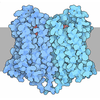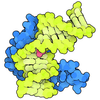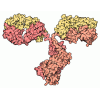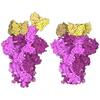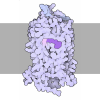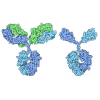[English] 日本語
 Yorodumi
Yorodumi- PDB-9jg0: Cryo-EM structure of neuropeptide FF receptor 2 in the ligand-fre... -
+ Open data
Open data
- Basic information
Basic information
| Entry | Database: PDB / ID: 9jg0 | |||||||||||||||||||||||||||
|---|---|---|---|---|---|---|---|---|---|---|---|---|---|---|---|---|---|---|---|---|---|---|---|---|---|---|---|---|
| Title | Cryo-EM structure of neuropeptide FF receptor 2 in the ligand-free state with BRIL fusion, anti-BRIL Fab, and nanobody | |||||||||||||||||||||||||||
 Components Components |
| |||||||||||||||||||||||||||
 Keywords Keywords | MEMBRANE PROTEIN / GPCR | |||||||||||||||||||||||||||
| Function / homology |  Function and homology information Function and homology informationopioid receptor binding / Orexin and neuropeptides FF and QRFP bind to their respective receptors / detection of abiotic stimulus / neuropeptide receptor activity / regulation of MAPK cascade / neuropeptide signaling pathway / cellular response to hormone stimulus / electron transport chain / G protein-coupled receptor activity / actin cytoskeleton ...opioid receptor binding / Orexin and neuropeptides FF and QRFP bind to their respective receptors / detection of abiotic stimulus / neuropeptide receptor activity / regulation of MAPK cascade / neuropeptide signaling pathway / cellular response to hormone stimulus / electron transport chain / G protein-coupled receptor activity / actin cytoskeleton / G alpha (q) signalling events / electron transfer activity / periplasmic space / G protein-coupled receptor signaling pathway / iron ion binding / heme binding / plasma membrane Similarity search - Function | |||||||||||||||||||||||||||
| Biological species |  Homo sapiens (human) Homo sapiens (human) synthetic construct (others) | |||||||||||||||||||||||||||
| Method | ELECTRON MICROSCOPY / single particle reconstruction / cryo EM / Resolution: 2.91 Å | |||||||||||||||||||||||||||
 Authors Authors | Kim, J. / Choi, H.-J. | |||||||||||||||||||||||||||
| Funding support |  Korea, Republic Of, 1items Korea, Republic Of, 1items
| |||||||||||||||||||||||||||
 Citation Citation |  Journal: EMBO Rep / Year: 2025 Journal: EMBO Rep / Year: 2025Title: Structural insights into the selective recognition of RF-amide peptides by neuropeptide FF receptor 2. Authors: Jeesoo Kim / Sooyoung Hong / Hajin Lee / Hyun Sik Lee / Chaehee Park / Jinuk Kim / Wonpil Im / Hee-Jung Choi /   Abstract: Neuropeptide FF Receptor 2 (NPFFR2), a G-protein-coupled receptor, plays a role in pain modulation and diet-induced thermogenesis. While NPFFR2 is strongly activated by neuropeptides FF (NPFFs), it ...Neuropeptide FF Receptor 2 (NPFFR2), a G-protein-coupled receptor, plays a role in pain modulation and diet-induced thermogenesis. While NPFFR2 is strongly activated by neuropeptides FF (NPFFs), it shows low activity in response to RF-amide-related peptides (RFRPs), despite the peptides belonging to a shared family. In contrast, NPFFR1, which shares high sequence similarity with NPFFR2, is activated by RFRPs and regulates reproductive hormone balance. The molecular basis for these receptor-specific interactions with their RF-amide peptides remains unclear. Here, we present cryo-electron microscopy structures of NPFFR2 in its active state bound to the agonist RF-amide peptide hNPSF, and in its ligand-free state. Structural analysis reveals that the C-terminal RF-amide moiety engages conserved residues in the transmembrane domain, while the N-terminal segment interacts in a receptor subtype-specific manner. Key selectivity-determining residues in NPFFR2 are also identified. A homology model of NPFFR1 bound to RFRP, supported by mutagenesis studies, further validates this selectivity mechanism. Additionally, structural comparison between the inactive and active states of NPFFR2 suggests a TM3-mediated activation mechanism. These findings provide insights into RF-amide peptide recognition by NPFF receptors. | |||||||||||||||||||||||||||
| History |
|
- Structure visualization
Structure visualization
| Structure viewer | Molecule:  Molmil Molmil Jmol/JSmol Jmol/JSmol |
|---|
- Downloads & links
Downloads & links
- Download
Download
| PDBx/mmCIF format |  9jg0.cif.gz 9jg0.cif.gz | 172.8 KB | Display |  PDBx/mmCIF format PDBx/mmCIF format |
|---|---|---|---|---|
| PDB format |  pdb9jg0.ent.gz pdb9jg0.ent.gz | 128 KB | Display |  PDB format PDB format |
| PDBx/mmJSON format |  9jg0.json.gz 9jg0.json.gz | Tree view |  PDBx/mmJSON format PDBx/mmJSON format | |
| Others |  Other downloads Other downloads |
-Validation report
| Summary document |  9jg0_validation.pdf.gz 9jg0_validation.pdf.gz | 1 MB | Display |  wwPDB validaton report wwPDB validaton report |
|---|---|---|---|---|
| Full document |  9jg0_full_validation.pdf.gz 9jg0_full_validation.pdf.gz | 1.1 MB | Display | |
| Data in XML |  9jg0_validation.xml.gz 9jg0_validation.xml.gz | 41.4 KB | Display | |
| Data in CIF |  9jg0_validation.cif.gz 9jg0_validation.cif.gz | 61.7 KB | Display | |
| Arichive directory |  https://data.pdbj.org/pub/pdb/validation_reports/jg/9jg0 https://data.pdbj.org/pub/pdb/validation_reports/jg/9jg0 ftp://data.pdbj.org/pub/pdb/validation_reports/jg/9jg0 ftp://data.pdbj.org/pub/pdb/validation_reports/jg/9jg0 | HTTPS FTP |
-Related structure data
| Related structure data |  61446MC  9jfyC M: map data used to model this data C: citing same article ( |
|---|---|
| Similar structure data | Similarity search - Function & homology  F&H Search F&H Search |
- Links
Links
- Assembly
Assembly
| Deposited unit | 
|
|---|---|
| 1 |
|
- Components
Components
| #1: Protein | Mass: 60471.199 Da / Num. of mol.: 1 Source method: isolated from a genetically manipulated source Details: 246 to 363 is soluble cytochrome b562 with linker Source: (gene. exp.)  Homo sapiens (human), (gene. exp.) Homo sapiens (human), (gene. exp.)  Gene: NPFFR2, GPR74, NPFF2, NPGPR, cybC / Production host:  |
|---|---|
| #2: Antibody | Mass: 24321.084 Da / Num. of mol.: 1 Source method: isolated from a genetically manipulated source Source: (gene. exp.)  Homo sapiens (human) / Production host: Homo sapiens (human) / Production host:  Trichoplusia ni (cabbage looper) Trichoplusia ni (cabbage looper) |
| #3: Antibody | Mass: 14461.796 Da / Num. of mol.: 1 Source method: isolated from a genetically manipulated source Source: (gene. exp.) synthetic construct (others) / Production host:  |
| #4: Antibody | Mass: 23483.062 Da / Num. of mol.: 1 Source method: isolated from a genetically manipulated source Source: (gene. exp.)  Homo sapiens (human) / Production host: Homo sapiens (human) / Production host:  Trichoplusia ni (cabbage looper) Trichoplusia ni (cabbage looper) |
| Has protein modification | Y |
-Experimental details
-Experiment
| Experiment | Method: ELECTRON MICROSCOPY |
|---|---|
| EM experiment | Aggregation state: PARTICLE / 3D reconstruction method: single particle reconstruction |
- Sample preparation
Sample preparation
| Component | Name: human neuropeptide FF receptor 2 in the apo state with BRIL fusion, anti-BRIL Fab, and nanobody Type: COMPLEX / Entity ID: all / Source: MULTIPLE SOURCES |
|---|---|
| Molecular weight | Value: 0.12 MDa / Experimental value: NO |
| Source (natural) | Organism:  Homo sapiens (human) Homo sapiens (human) |
| Source (recombinant) | Organism:  |
| Buffer solution | pH: 8 |
| Specimen | Embedding applied: NO / Shadowing applied: NO / Staining applied: NO / Vitrification applied: YES |
| Vitrification | Cryogen name: ETHANE |
- Electron microscopy imaging
Electron microscopy imaging
| Experimental equipment |  Model: Titan Krios / Image courtesy: FEI Company |
|---|---|
| Microscopy | Model: TFS KRIOS |
| Electron gun | Electron source:  FIELD EMISSION GUN / Accelerating voltage: 300 kV / Illumination mode: FLOOD BEAM FIELD EMISSION GUN / Accelerating voltage: 300 kV / Illumination mode: FLOOD BEAM |
| Electron lens | Mode: BRIGHT FIELD / Nominal defocus max: 2000 nm / Nominal defocus min: 800 nm |
| Image recording | Electron dose: 60 e/Å2 / Film or detector model: GATAN K3 BIOQUANTUM (6k x 4k) |
- Processing
Processing
| CTF correction | Type: PHASE FLIPPING AND AMPLITUDE CORRECTION |
|---|---|
| 3D reconstruction | Resolution: 2.91 Å / Resolution method: FSC 0.143 CUT-OFF / Num. of particles: 324660 / Symmetry type: POINT |
 Movie
Movie Controller
Controller



 PDBj
PDBj
